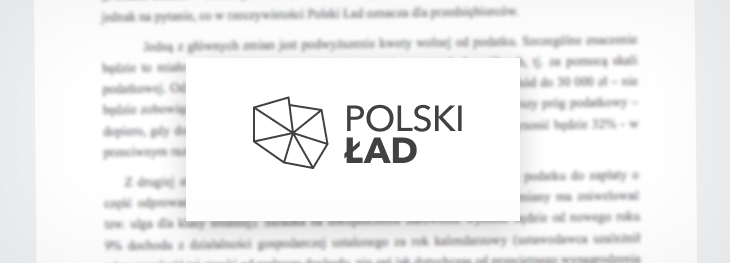Polish Order - Changes from 2022
With the new year, a tax revolution called "Polish Order" also comes into force. There are many changes, some less, some more beneficial. Let's answer the question, what does the Polish Order actually mean for entrepreneurs?

One of the main changes is the increase in the tax-free amount. This will have particular significance for entrepreneurs who are taxed on general terms, i.e. using the tax scale. From January 1, 2022, if such an entrepreneur earns up to 30,000 PLN - he will not be obliged to pay tax. What's more, the first tax threshold has been increased - only when annual income exceeds 120,000 PLN, the tax on the surplus will be 32% - otherwise the tax will be 17%.
On the other hand, taxpayers have been deprived of the possibility of reducing the tax to be paid by part of the health contribution paid (partially negative effects of this change will be offset by the so-called middle class relief). The health contribution will be from the new year 9% of the income from business activity established for the calendar year (the legislator has therefore linked the amount of this rate to the actual income, not as before to the average monthly salary) - it will therefore be calculated as income reduced by the amount of pension, disability, health and accident insurance contributions paid in this year, if they have not been included in the costs of obtaining income (but it cannot be lower than the one paid within the minimum wage applicable this year - so in 2022 it will be at least PLN 270.90). The health contribution becomes a kind of new tax. Entrepreneurs are entitled to a refund of the overpaid health contribution if the total contributions paid during the year are higher than the basis for calculating the contribution. The deadline for paying the health contribution has also been shifted - currently it must be done by the 20th day of the month.
A so-called middle-class relief was also introduced - a taxpayer obtaining income from business activity will have the possibility to reduce the income by the amount of relief for taxpayers obtaining income from non-agricultural business activity (the amount of relief depends on the amount of income - we do not take into account the costs incurred). Those entrepreneurs who have achieved revenues of at least PLN 68,411.99 and max. PLN 133,692.01 will be able to take advantage of the relief. In addition to the middle-class relief, you can also take advantage of such reliefs as the thermal modernization relief, the research and development relief or the IP Box.
From 1 January 2022, for entrepreneurs taxed only with the flat tax, the health insurance contribution will be 4.9%. However, it should be borne in mind that the monthly amount of the contribution cannot be lower than the amount established as 9% of the minimum wage, and the contribution established on the annual base cannot be lower than the amount corresponding to 9% of the product of the number of months subject to insurance and the minimum wage.
Changes were also introduced in the scope of the flat tax on recorded income. The Polish Order provides for the reduction of some tax rates. Two new flat tax rates have been added to the Act on the Flat Tax - they will apply to taxpayers from certain industries or providing certain services. From the beginning of 2022, new ones will be added to the existing rates, such as: 12% for income obtained in connection with the provision of certain IT services (previously subject to a 15% rate), which are mainly related to the issuance of computer software (excluding downloading software online) and IT advice, or 3% for certain income obtained, inter alia, from trade, fishing activities, gastronomy (unless it concerns the sale of alcoholic beverages above 1.5%), animal production (other than veterinary activities), and the sale of movables related to business activity.
Other changes will include such changes as consumers being able to pay companies only by transfer if the transaction exceeds 20,000 PLN, the sale of items (especially cars) purchased from leasing to private property will be treated as income from business activity, and the so-called checking acquisition will appear - the tax office can buy something from the entrepreneur to check if the sale is charged to the cash register. What's more, all accounting books (both CIT and PIT) and records of fixed assets and intangible and legal assets must be kept electronically.
Another assumption of the Polish Order is the popularization of the cashless form of settling transactions. The provisions of the Polish Order impose on entrepreneurs the obligation to provide the possibility of making payments using cashless payment instruments. The necessity of introducing the possibility of cashless payments applies to those entrepreneurs who are obliged to keep records of sales using cash registers. The Polish Order introduces a relief for taxpayers who have incurred expenses for the purchase of a payment terminal and expenses related to payment transactions. These expenses will be deductible from the tax base both in the case of taxation on general terms according to the tax scale and in the flat tax.
In the context of the Polish Order, it is also worth noting the advantages of conducting business in the form of a limited liability company. This allows for the exclusion of personal liability for the company's obligations. The liability of the shareholders is thus separated from the liability of the company - the shareholders are not liable for the company's obligations, and the execution can be carried out from the assets of the limited liability company, but not from the assets of its shareholder.
The subject of taxation in this company is income consisting of the sum of income from capital gains and income from other sources of income. This means that income for each of these sources is calculated separately as the difference between revenues and costs from that source. The company as a CIT taxpayer pays income tax at the rate:
Income earned by a limited liability company is subject to taxation at the company level and at the level of the shareholders. This means that the shareholders are not taxed on an ongoing basis for the business activity carried out by the LLC - only the payment of their share of the profit creates income to be taxed.
In such a situation, a shareholder who is a PIT taxpayer will recognize income from the share of profits of legal entities taxed at a flat rate of 19%. In the case of a shareholder of an LLC who is also a CIT taxpayer, this rate is also 19%, but here there may be an exemption from tax. This will be possible, for example, if he directly and uninterruptedly holds at least 10% of the capital of the company whose profit is to be divided for at least two years (so-called dividend exemption). The income of an LLC shareholder from the paid dividend is classified as income from cash capital (from profits of legal entities) and as such is not taken into account when determining the basis for calculating the solidarity tax. In this context, one can point to the preference for the taxation of LLC shareholders over persons obtaining income from non-agricultural business.
The above preliminary data on these huge tax changes do not, of course, even provide a comprehensive indication of all the changes that have taken effect since the introduction of the Polish Order. Nevertheless, work is already underway on the amendment of these regulations, as in many sectors, both private and public, the changes initiated have resulted in a real decrease in income and a significant increase in labor costs or the cost of conducting business.
 This article was prepared by the Law Office of Arkadiusz Jaskuła, which provides legal services to companies, also offering services to SOTE and our customers: www.adwokat-jaskula.pl
This article was prepared by the Law Office of Arkadiusz Jaskuła, which provides legal services to companies, also offering services to SOTE and our customers: www.adwokat-jaskula.pl
Order a professional regulations for your online store
Related Pages

